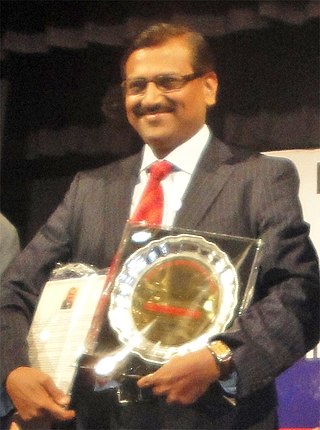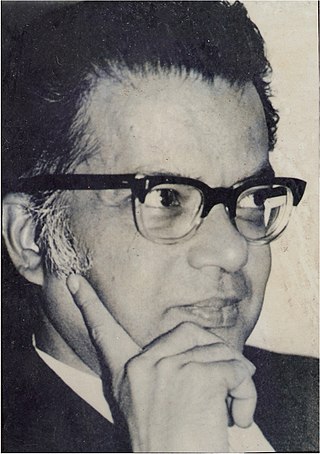
Nandan Mohanrao Nilekani is an Indian entrepreneur. He co-founded Infosys and is the non-executive chairman of Infosys replacing R Seshasayee and Ravi Venkatesan, who were the co-chairs of the board, on 24 August 2017. After the exit of Vishal Sikka, Nilekani was appointed as non-executive chairman of the board effective 24 August 2017. He was the chairman of the Unique Identification Authority of India (UIDAI). After a successful career at Infosys, he headed the Government of India's technology committee, TAGUP. He is a member of Indian National Congress but not active in politics as of 2019.
Minimally invasive education (MIE) is a form of learning in which children operate in unsupervised environments. The methodology arose from an experiment done by Sugata Mitra while at NIIT in 1999, often called The Hole in the Wall, which has since gone on to become a significant project with the formation of Hole in the Wall Education Limited (HiWEL), a cooperative effort between NIIT and the International Finance Corporation, employed in some 300 'learning stations', covering some 300,000 children in India and several African countries.

Rajendra Singh Pawar is an Indian entrepreneur, chairman and co-founder of NIIT Limited, established in 1981. He also founded NIIT University, a not-for-profit university in Neemrana, Rajasthan, in 2009.
Pratham is one of the largest non-governmental organisations in India. It was co-founded by Madhav Chavan and Farida Lambay. It works towards the provision of quality education to the underprivileged children in India. Established in Mumbai in 1995 to provide pre-school education to children in slums, Pratham today has interventions spread across 23 states and union territories of India and has supporting chapters in the United States, UK, Germany, Sweden, and Australia.
Swami Manohar, otherwise known as Manohar Swaminathan, is a co-founder and the CEO of PicoPeta Simputers Pvt. Ltd. He completed his undergraduate program in Electronics and Communication Engineering in Government College of Technology, Coimbatore during which he was a part of a campus team that designed an Electronic Voting machine in the year 1981, which was actually the first designed in India. After obtaining his PhD in Computer Science from Brown University he was a faculty at the University of North Carolina for two years and then was at the Indian Institute of Science (IISc), Bangalore, between 1990 and 2005. He was on the faculty of the department of Computer Science and Automation (CSA) and the Supercomputer Education and Research Center (SERC) at the Institute. He has been a visiting faculty at Columbia University, University of Missouri and the University of Texas. While at IISc, he co-invented the Simputer, was awarded the Dewang Mehta Award for Innovation in IT, and pioneered the faculty entrepreneurship activity at IISc, which has since catalyzed similar activity in IITs and other educational institutes in India. He co-founded Strand Life Sciences, and String Labs, the first academic incubating company in India.

Anant Agarwal is an Indian computer architecture researcher. He is a professor of Electrical Engineering and Computer Science at the Massachusetts Institute of Technology (MIT), where he led the development of Alewife, an early cache coherent multiprocessor, and also has served as director of the MIT Computer Science and Artificial Intelligence Laboratory. He is the founder and CTO of Tilera, a fabless semiconductor company focusing on scalable multicore embedded processor design. He also serves as the CEO of edX, a joint partnership between MIT and Harvard University that offers free online learning.
Byrana Nagappa Suresh is an Indian aerospace scientist. He serves as chancellor of the Indian Institute of Space Science and Technology (IIST) in Thiruvananthapuram and is a professor at ISRO Headquarters.

Bett or The Bett Show is a global series of education shows organised by Hyve Group marketing information technology in education. The flagship show is located in the UK, with satellite events in Asia & Brasil. Bett is also the global community for education technology, which hosts webinars, CPD sessions and publish articles from the leaders in education.
Kiran Karnik is a prominent Indian administrator chiefly known for his work in the broadcasting and outsourcing industries. Presently he is also serving as a director in Central board of directors of Reserve Bank of India. He is also the chairman, board of directors, of the Indraprastha Institute of Information Technology, Delhi (IIIT-D).

NIIT Limited (National Institute of Information Technology) is an Indian multinational skills and talent development corporation headquartered in Gurgaon, India. The company was set up in 1981 to help the nascent IT industry overcome its human resource challenges. NIIT offers training and development to individuals, enterprises and institutions.

Dr. Uday Salunkhe is the director of the Welingkar Institute of Management Development & Research, Mumbai and Bangalore. He is the chairman of Ad Hoc Board of Studies in Management Courses of Mumbai University and Chairman of the Local Management Committee of Association of Management Development Institutions in South Asia (AMDISA) – a SAARC initiative. He took over as the President of Association of Indian Management Schools (AIMS) for year 2007–2008. AIMS is the 2nd largest body of management schools in the world with more than 500 member. His work is strongly influenced by the likes of Jack Welch and Arya Chanakya.
One Peace at a Time is a film by Turk and Christy Pipkin. It was produced by The Nobelity Project and was premiered at the Paramount Theatre in Austin, Texas, USA, on April 14, 2009. It is the sequel to the film Nobelity. It has been shown in various countries.

St. Martin's Engineering College (SMEC) is a private engineering college located in Secunderabad, Telangana, India.

Arvind Gupta is an Indian science educator, toy inventor, author, translator and scientist. He received the civilian award Padma Shree from the Indian government on the eve of Republic Day, 2018.

Chittaranjan Mitra, popularly known as CR Mitra and CRM, was an Indian scientist who is best remembered as the second Director of the Birla Institute of Technology and Science Pilani (BITS). He played a pivotal role in the transformation of the institute from a local engineering college to a reputed university.
Mitra is a Bengali Hindu surname found mostly amongst the Bengali Kayastha community and occasionally among other communities like Barujibi in the Bengal region of the Indian subcontinent. The surname may have been derived either from the Sanskrit word Mitra, meaning friend or ally, or from the name of an important Indo-Iranian deity in the Vedas and in ancient Iran.
Giri 'Pickbrain' Balasubramaniam is the founder and chief executive officer of Greycaps, India's largest on stage quizzing and knowledge service provider. He is nicknamed Pickbrain.
A Self Organized Learning Environment (SOLE) is a program designed to support self-directed education. Sugata Mitra, an education scientist, first popularized the term in 1999, referencing an approach he developed following his Hole in the Wall experiments. Mitra's experiments demonstrated that groups of kids could learn to navigate computers and the internet by themselves, and "research since then has continued to support his startling conclusion that groups of children, with access to the Internet, can learn almost anything by themselves." Starting in 2014, he's worked with and through the School in the Cloud project to support the development of SOLEs around the world, adding "Granny" mentors and Big Questions as key components of such programs.

Fei-Fei Li is a Chinese-American computer scientist, known for establishing ImageNet, the dataset that enabled rapid advances in computer vision in the 2010s. She is the Sequoia Capital professor of computer science at Stanford University and former board director at Twitter. Li is a co-director of the Stanford Institute for Human-Centered Artificial Intelligence and a co-director of the Stanford Vision and Learning Lab. She served as the director of the Stanford Artificial Intelligence Laboratory from 2013 to 2018.

Manas Bihari Verma was an Indian aeronautical scientist instrumental in the development of the light combat aircraft, Tejas. In 2018, he was conferred the Padma Sri civilian honour by the President of India. After his retirement he launched Mobile Science Lab aimed at promoting science education in Bihar.












